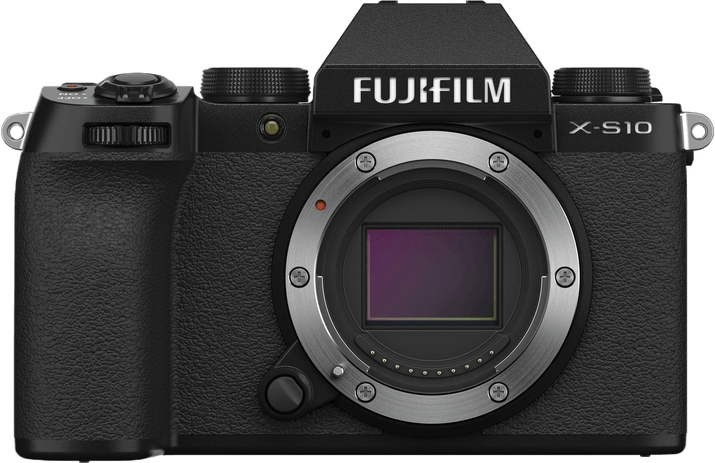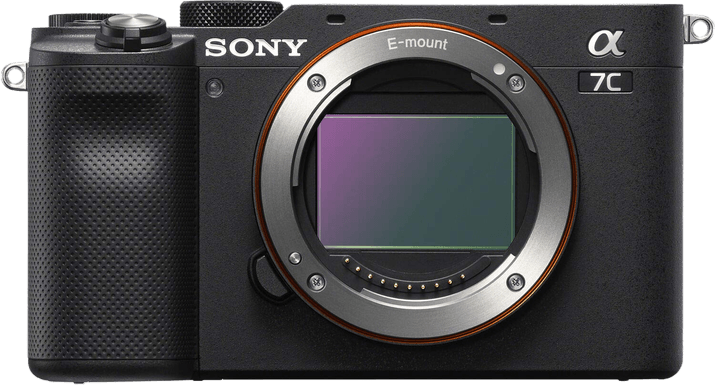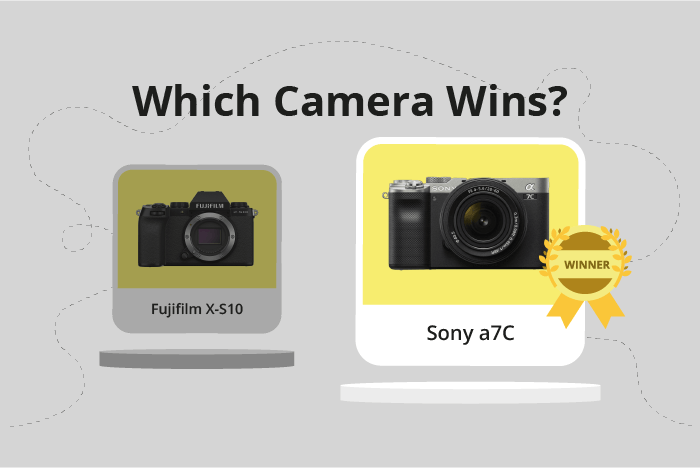Fujifilm X-S10 vs Sony a7C Comparison
Fujifilm X-S10

Sony a7C

The Sony a7C outshines the Fujifilm X-S10 with a score of 78/100 compared to 69/100. Both cameras are mirrorless and were released in 2020, with the X-S10 priced at $999 and the a7C at $1799. They share similar dimensions, but the a7C is slightly heavier at 509g while the X-S10 weighs 465g.
The Sony a7C’s higher score reflects its superior performance and features. However, the Fujifilm X-S10 has its advantages, such as being more budget-friendly and lighter in weight. When considering these factors, the Sony a7C proves to be the better choice for those seeking top-notch quality, while the Fujifilm X-S10 offers a more affordable option without sacrificing too much in performance.
Fujifilm X-S10 vs Sony a7C Overview and Optics
The Sony a7C outperforms the Fujifilm X-S10 in optics, scoring 80 out of 100, compared to the X-S10’s 72. Both cameras share several specifications, including a CMOS sensor, image stabilisation, and lens mounts designed for their respective brands. However, there are notable differences that contribute to the Sony a7C’s higher score.
The Sony a7C has a full-frame sensor, while the Fujifilm X-S10 features an APS-C sensor. Full-frame sensors generally produce better image quality, particularly in low light conditions. Furthermore, the a7C’s sensor earned a 95 DXOMARK score, a reputable benchmark for sensor quality. Although DXOMARK does not rate Fujifilm cameras, the full-frame advantage is clear.
Despite having lower megapixels (24.2) than the Fujifilm X-S10 (26), the Sony a7C delivers superior image quality, thanks to its full-frame sensor and Bionz X processor. The a7C’s processor is known for its excellent noise reduction and image processing capabilities.
The Fujifilm X-S10 does have an edge in shooting speed, boasting 20 frames per second (fps) against the Sony a7C’s 10 fps. This advantage makes the X-S10 more suitable for capturing fast-moving subjects, such as sports or wildlife photography.
The Sony a7C’s superior sensor and image processing make it the better choice for photographers seeking top-notch image quality. However, the Fujifilm X-S10’s faster shooting speed may appeal to those who prioritize capturing fast action. Ultimately, the Sony a7C leads in optics, but the Fujifilm X-S10 remains a strong contender for specific photography needs.
Fujifilm X-S10 vs Sony a7C Video Performance
The Fujifilm X-S10 outperforms the Sony a7C in video capabilities with a score of 91/100, a significant 21-point difference compared to the Sony a7C’s 70/100. Both cameras have 4K video resolution and built-in time-lapse functionality, making them suitable for various video projects.
The Fujifilm X-S10 excels in video performance due to its higher maximum video dimensions of 4096 x 2160 and a maximum video frame rate of 240fps. These features enable the X-S10 to capture more detailed and smoother footage, providing better quality for professional videographers and enthusiasts alike.
Although the Sony a7C has a lower score, it still offers 4K video resolution with maximum video dimensions of 3840 x 2160. However, its maximum video frame rate is only 30fps, which may not be sufficient for capturing fast-paced action or achieving smooth slow-motion effects. Despite this limitation, the a7C remains a capable camera for video projects that do not require high frame rates.
In comparing the video capabilities of the Fujifilm X-S10 and the Sony a7C, the X-S10 is the clear winner due to its superior video dimensions and frame rate. This makes it a more versatile and powerful camera for video projects requiring high-quality footage and smooth slow-motion effects. On the other hand, the Sony a7C is still a viable option for those who prioritize 4K resolution and do not need the higher frame rates offered by the X-S10.
Fujifilm X-S10 vs Sony a7C Features and Benefits
The Sony a7C outperforms the Fujifilm X-S10 in features, scoring 81/100 compared to the X-S10’s 70/100. Both cameras share several specifications, such as a 3-inch touchscreen with flip screen capabilities, and Bluetooth connectivity. However, there are notable differences that contribute to the Sony a7C’s higher score.
The Sony a7C surpasses the Fujifilm X-S10 with its Wi-Fi connectivity, which the X-S10 lacks. This feature allows the a7C users to transfer photos and videos wirelessly, making it more convenient for sharing content. Additionally, the a7C has a slightly lower screen resolution at 921,600 dots compared to the X-S10’s 1,040,000 dots. Despite this difference, the a7C still delivers a clear and sharp display for users.
On the other hand, the Fujifilm X-S10 has some advantages over the Sony a7C. Its higher screen resolution provides a more detailed display for reviewing images and videos. However, this advantage may not be significant enough to compensate for the absence of Wi-Fi connectivity.
Considering these factors, the Sony a7C proves to be the better camera in terms of features. Its Wi-Fi capability offers a significant advantage for users who value easy sharing and transferring of their content. While the Fujifilm X-S10 has a slightly higher screen resolution, it does not outweigh the benefits provided by the a7C. Therefore, the Sony a7C is the preferable choice for those prioritizing advanced features in their camera selection.
Fujifilm X-S10 vs Sony a7C Storage and Battery
The Sony a7C wins in the storage and battery category, scoring 45/100, while the Fujifilm X-S10 scores 35/100. Both cameras have one memory card slot and offer USB charging. However, the Sony a7C has superior battery life and storage compatibility.
The Sony a7C has a battery life of 740 shots, significantly more than the Fujifilm X-S10’s 325 shots. Its battery type is NP-FZ100, and it accepts SD, SDHC, and SDXC memory cards with UHS-II compatibility. This gives the Sony a7C an edge in storage and battery performance.
The Fujifilm X-S10 has a battery life of 325 shots and uses an NP-126S battery. It accepts SD, SDHC, and SDXC memory cards with UHS-I compatibility. While inferior to the Sony a7C in terms of battery life and storage compatibility, it still provides decent performance in this category.
Considering the specifications, the Sony a7C clearly outperforms the Fujifilm X-S10 in storage and battery capacity. This advantage makes the Sony a7C a better choice for photographers who require longer battery life and enhanced storage compatibility.
Fujifilm X-S10 vs Sony a7C – Our Verdict
Are you still undecided about which camera is right for you? Have a look at these popular comparisons that feature the Fujifilm X-S10 or the Sony a7C:

